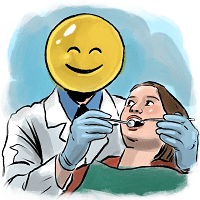Dealing with Anxious Patients
By Leesa Scott-Morrow, Ph.D., J.D., LP
 Everyone reading this will not only have heard the phrase “fight-or-flight response,” but they will have experienced it, too, enough to know that it is a primarily biological event. The amygdalae — two small, almond-shaped structures situated deep in the temporal lobes of the brain — fire the fight-or-flight response. Interestingly enough, research shows that the amygdalae also play a primary role in reading facial expression. This makes sense when you consider that reading facial expression is critical to determining whether or not people pose a threat.
Everyone reading this will not only have heard the phrase “fight-or-flight response,” but they will have experienced it, too, enough to know that it is a primarily biological event. The amygdalae — two small, almond-shaped structures situated deep in the temporal lobes of the brain — fire the fight-or-flight response. Interestingly enough, research shows that the amygdalae also play a primary role in reading facial expression. This makes sense when you consider that reading facial expression is critical to determining whether or not people pose a threat.
Displaying primary emotion through facial expression is also wired into our brains. We do not think before changing our facial expression; our facial expression changes as an automatic function of our emotional state. Social research shows that all people show a range of primary emotions on their faces, including fear, anger, disgust, surprise, happiness and sadness. All people can read these emotions in others regardless of disparate cultural identity, native language, gender, age, education level or nation of origin. We identify these emotions through facial expression in milliseconds, without trying, and without thinking. In addition, we instantly show these emotions without thinking. The point of this is that the face is not like other body parts. Its motor functions are heavily wired to the brain centers that underlie our social natures.
Your face and your assistant’s face fill the patient’s view as you deliver treatment. The patient is likely to be experiencing significant facial pain, which is arguably more provocative than pain in other anatomy due to the primacy of the face. Under these unique conditions, it is normal for patients to be apprehensive. However, some patients are especially apprehensive to the point of having an anxiety disorder. Anxious patients are under the powerful influence of stress hormones as they sit in the dental operatory. Keep in mind that anxious patients are anxious about most things. Research teaches us that repeated firings of the fight-or-flight system rewire the brain so that it interprets ever more stimuli as threatening. As this neural process generalizes, the system fires with less and less provocation. In other words, the fight-or-flight response is amplified through something like a practice effect, especially in individuals who are genetically predisposed to anxiety.
People who are in the throes of the fight-or-flight response cannot process anything but the simplest language. You can calmly outline what you are about to do, but intensely anxious patients cannot process what you are saying. Their brains are undergoing an electrical storm that has one purpose and that is to escape or suppress perceived danger. Yet, the patient cannot run away, or fight you, because they cannot do their own root canal. This is a tough spot, for the patient, and for you.
So, what are you to do? First, don’t personalize the patient’s anxiety. You didn’t cause it. They came to see you primed with fear. Second, don’t let the patient’s anxious fear infect you with anxiety. Fear is naturally infectious. Nature wired us that way because it is most efficient if we can respond to warnings of danger rather than to actual danger. Nevertheless, research indicates that we can learn to override the infectious aspect of fear with self-awareness. Third, when you sense that you have an anxious patient in front of you, do not attempt to comfort the patient with a barrage of words. Remember, the anxious patient cannot effectively process language. Keep it simple. Ask the patient if they are nervous – say nervous, not anxious – and then tell them that most people are nervous before a root canal, but that it’s going to be okay. In so doing, you strip away any worry the patient may have about appearing emotionally defective or weak. Tell the patient that you are going to take great care of them. Leave it at that, then confidently move into the procedure. Remember, the patient is scanning your face.
What they see there will have far more impact than any words you might say. Feel confident, and you will look confident. Feel caring, and you will look caring. Allow yourself to become fully absorbed in doing great dentistry; this will immunize you against infectious anxiety, and it will comfort your patient to whatever extent that is possible to do. Understand that anxious patients avoid treatment, which not only aggravates dental disease, it compounds the patient’s fear. This creates a scenario in which anxious patients present more serious disease that can be hard to treat without generating pain. Dealing with the patient’s self-fulfilling prophecy is frustrating, of course; but it does not help to chide the anxious patient as this only aggravates their avoidant tendencies. Instead, move immediately to treatment because, in the end, beneficial treatment is the best remedy for both the patient’s fear and their dental disease.
Dr. Leesa Scott-Morrow recently held a position with Health Partners Interventional Pain Management in the Department of Neurosciences before beginning a private practice, where she now devotes her professional time. Dr. Scott-Morrow regularly speaks on a national level regarding the management of medically complex patients who have significant psychological overlay.




